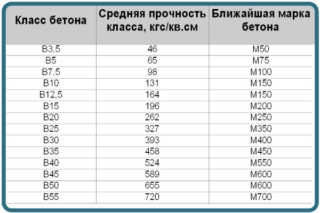The durability of the building depends on the quality of the base. The correct calculation of concrete is important for professional builders and for self-laying foundations. During the design, it is necessary to calculate the amount of concrete and constituent components.
The need for calculations

During construction, it is important to find out the total amount of materials required already at the design stage. Data helps:
- Purchase only the components you need. Excessive materials cost money, and some of them cannot be stored for long.
- Avoid the cost of re-delivery if something was missing when arranging the foundation.
- Control the contractor, prevent fraud and overstatement.
- Purchase the exact amount of concrete from the factory. The foundation is poured in one step, the shortage will have to be delivered on the same day, which will take time and money to pay for the downtime of the hired workers. The surplus must be disposed of in some way, which is not always possible.
Financial planning depends on accurate knowledge.
Concrete types
Concrete grades are used in civil engineering:
- M100 is the least durable, it is used exclusively for the construction of sheds and foundations for fences;
- M150 is used only in strip foundations for small buildings - sheds, baths, garages, wooden country houses;
- M250, M300, with the correct calculation of the base area, will withstand buildings up to 5 floors;
- M350 is used in conditions of high humidity and in the northern regions for the foundations of multi-storey brick houses;
- M400 is too strong for private houses, it is able to withstand a mass of buildings up to 20 floors high.
The concrete grade for the foundation must be indicated in the project.
Concrete composition
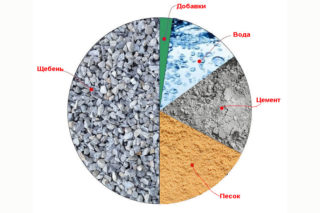
Foundation concrete includes:
- cement;
- filler;
- sand;
- plasticizer and additives for work at low temperatures.
Their proportions during mixing depend on the characteristics of the components.
Cement
The industry produces cement grades from M300 to M600. Reinforced concrete factories use M500 raw materials.
In retail outlets, the M400 is most often found. Therefore, they are guided by this brand, making a calculation of the composition of concrete for self-production.
If you managed to purchase M500 cement at a profit, you can calculate the number of components using a special table.
When buying, pay attention to the date of manufacture and storage conditions. The material is hygroscopic and even on platforms with a roof can lose its properties or harden.
Excipients
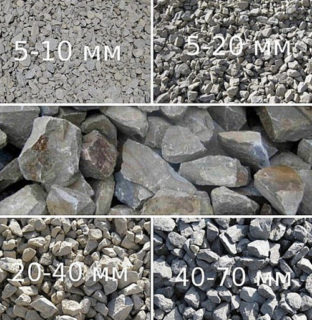
Gravel and crushed stone are used as filler for foundation concrete. Both materials are of natural origin and differ only in the type of rock from which they are made.
When crushing, material of irregular shape is obtained.
Important characteristics that are taken into account when calculating concrete are fractionation, flakiness and strength.
The fraction corresponds to the size of the particles of crushed stone or gravel that make up the basis of the material. The larger the fraction, the more sand will be required to fill the voids between the individual filler particles in the manufacture of concrete.
For strip and slab foundations, choose a filler from 20 to 40 mm in diameter.
For concrete of columnar and pile foundations, a fraction of not more than 20–25 mm is used. At large sizes, it will be difficult to fill and compact deep foundations.
Large fractions increase the volume of sand in the concrete, which reduces the strength of the monolithic foundation.
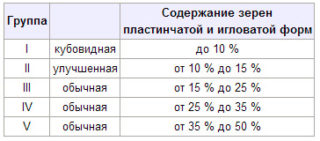
Flakiness shows how different the components of crushed stone are in shape. Measured as a percentage. The lower the indicator, the more suitable gravel is for building a foundation. There are five groups of flakiness:
- No. 1 non-standard stones make up no more than 10% by weight, used for any foundations;
- No. 2 - improved group, 10-15% stones of irregular shape, suitable for foundations;
- No. 3 (15–25%) is most often obtained by crushing limestone, it is not suitable for foundations;
- No. 4 (25–35%) in the construction of foundations is only suitable for creating a pillow;
- No. 5 (35-50%) is cheaper than others and is sometimes used when pouring the foundations of sheds and other light buildings.
Strength indicates the ability of the filler to withstand loads and can range from M200 to M1400.
In the construction of residential buildings, M800 is used under the pillow, and M1200 is chosen for the concrete filler of the foundation.
In monolithic concrete foundations for sheds and fences, crushed stone of the M600 or M800 brand is used.
Slag of metallurgical industries is not used as a concrete filler for the foundation - it is heterogeneous in composition and characteristics. Limestone crushed stone is low in strength and short-lived, it is also unsuitable.
Sand is divided by particle size into fine (up to 1.2 mm), very fine (1.2-1.6), fine (1.6-2), medium (2-2.5) and coarse (2.5 –3).
Thin and coarse ones are not used in concrete - it is difficult to work with such a fraction, the material settles, and the mixture turns out to be fragile. In concrete with coarse sand, water separates from the mixture, which should not be allowed at the time of solidification of the monolith.
Additives
To simplify mixing, giving the solution plasticity, plasticizers are added to the concrete composition.
For industrial additives, the manufacturer specifies the exact dosage that should not be exceeded. The increased consumption increases the total cost and negatively affects the strength of the concrete.
Clay is a natural free plasticizer available in almost all regions. The required amount of such raw materials is determined empirically.
At temperatures from -5 ° C and below, components that prevent rapid freezing must be added to the composition. Without such additives, concrete will collapse within a few years.
Consumption of components per cubic meter of concrete
Depending on the fractions of crushed stone and sand, the total consumption of components may vary slightly, but the data in the table can be taken as a basis.
The composition of concrete from cement grade M400.
| Components | Received concrete grade | ||||
| M100 | M200 | M250 | M300 | M400 | |
| Cement, kg | 180 | 260 | 320 | 340 | 440 |
| Sand, kg | 840 | 740 | 780 | 640 | 530 |
| Crushed stone, kg | 1280 | 1270 | 1160 | 1250 | 1200 |
| Water, l | 90 | 130 | 160 | 220 | 220 |
| Proportions by mass of CxPxCxV | 1x4.6x7.1x0.5 | 1x2.8x4.8x0.5 | 2.4x3.6x0.5 | 1x1.8x3.7x0.6 | 1x1.2x2.7x0.5 |
| Approximate proportions of components TskhPkhShch, bucket * | 1х4х5.6 | 1x2.5x3.9 | 1x2.1x2.8 | 1x1.6x2.5 | 1x1.3x2.1 |
The data is given for a bucket with a volume of 10 liters.The proportions are indicated for a fraction of crushed stone up to 20 mm and a voidage of 30%.
To measure the voidness of the filler, rubble is poured into a 10-liter bucket and water is gradually poured. If 3 liters are included, the void is 30%, if 4 liters, then 40%, etc. More sand and cement will be needed for complete filling.
Total volume of foundations
Calculating the volume of concrete for a foundation can be done using online calculators on many sites.
However, the school geometry course is enough to understand how to calculate the volume of concrete for any base configuration.
Strip foundation

The tape-type foundation is a monolithic structure that runs under the entire house. Load-bearing walls and partitions are built on it.
You can calculate the volume of concrete for such a base by expanding all sides of the foundation into elementary parallelepipeds.
First, multiply the length, width and height of the prepared formwork along the long side of the house. Next, you need to calculate the volumes of the parallelepipeds of the short sides.It is important not to take into account the previously calculated volumes of the corners in their length. All measurements are carried out only after the formwork has been installed, this will help eliminate errors.
The final formula must be amended - add a margin of 2%. This is due to the fact that during pouring, the formwork can disperse by several centimeters, increasing the internal volume.
The general formula looks like this: V = h + b + l + 0.02 (h + b + l).
- h- formwork height;
- b - tape width;
- l— the length of the sides.
For example, the calculation of the concrete volume for a 6x10 m foundation with one lintel along short walls is given. The height and width of the formwork is 0.5 m.
- The total volume of the long sections of the foundation is 2x10x0.5x0.5 = 5 cubic meters. Where 2 - 2 long walls, 10 - wall length, 0.5 and 0.5 - width and height of the formwork.
- The length of the short wall for the calculation is 6-0.5-0.5 = 5 meters. Where 6 is the total length of the short wall, 0.5 and 0.5 is the thickness of the long wall, which has already been taken into account in clause 1.
- The total volume of the short walls is 3x5x0.5x0.5 = 3.75 m3.
- In total, concrete is required 5 + 3.75 + 0.02x (5 + 3.75) = 8.925 m3.
Having rounded the obtained result to whole values, they acquire or prepare material for 10 m3 of concrete.
Column foundation
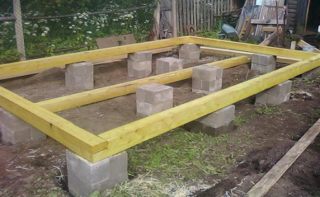
Columnar foundations are used on heavy and moving soils.
In most cases, a grillage is arranged around the pillars, therefore the calculation consists of two steps: they find out the volume of the pillars and add the volume of the grillage to the result.
If the pillars are a cylinder, its volume is calculated by the formulaV = Sхhwhere:
- S - base area;
- h - the height of the column.
The base area is calculated by the formula S = 3.14xR2. Total: V = 3.14 * R * R * h.
Example. 1 pillar with a radius of 0.15 m and a height of 1 meter will require 3.14 * 0.15 * 0.15 * 1 = 0.07 m3 of concrete. 8 bases will take 8 * 3.14 * 0.15 * 0.15 * 1 = 0.56m3.
If there is a monolithic concrete grillage, it is calculated similarly to the strip foundation and added to the volume of the posts. For rectangular piles, it is enough to multiply the height, width and depth of the base.
Platen

The slab foundation is a solid monolithic slab under the entire building. It is easiest to calculate the volume of concrete for such a base. It is enough to multiply the length, width of the house and the height of the monolithic slab.
Formula: V = l * b * hwhere V - overall volume, l - long wall of the house, b - short wall, h - slab height.
Example. The dimensions of the house are 6x10 m, the thickness of the foundation is 30 cm. V = 6 * 10 * 0.3 = 18 m3.
The calculation of concrete for the foundation is quite simple to do if you carefully approach the measurement of the prepared formwork. The exact figure will help to avoid many problems during the construction phase, eliminating additional costs.

